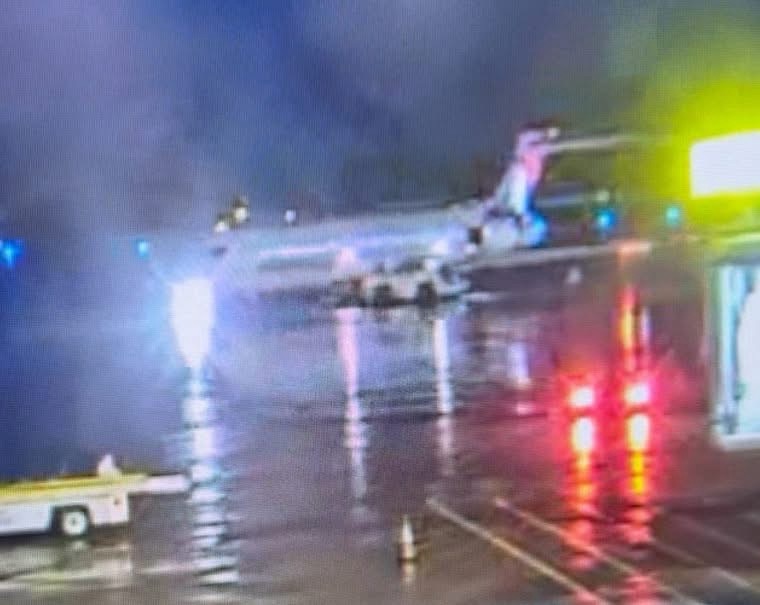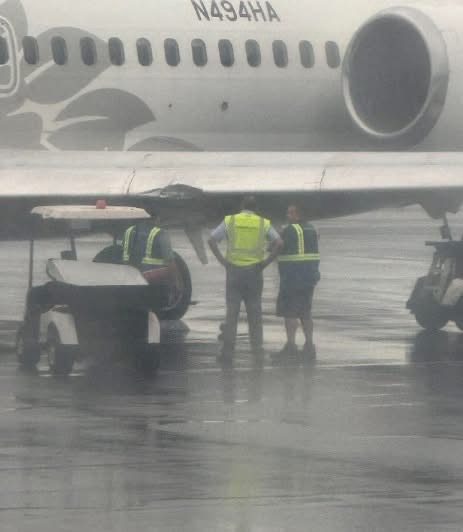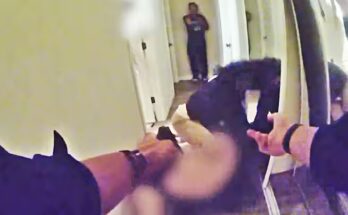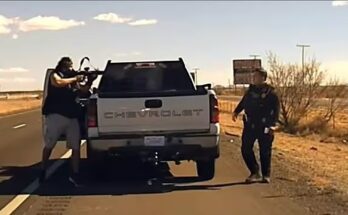
*** Final Report ***
N494HA Boeing 717 Kahului Hawaii 30 NOV 2023
1 Minor & 119 No Injuries
Captain The captain, age 29, held an airline transport pilot certificate with a multi-engine land rating, commercial pilot privileges for airplane single-engine land, and type ratings on the B-757, B 767, and DC-9. He held an FAA first-class medical certificate dated March 8, 2023, with the limitation, “Must use corrective lens(es) to meet vision standards at all required distances.” The captain stated that he was wearing corrective lenses at the time of the incident. The captain was hired by Hawaiian Airlines on June 1, 2022, and had accumulated about 3,300 hours total flight time, about 1,200 hours of which were in the B-717.
First Officer The FO, age 35, held an airline transport pilot certificate with a multi-engine land rating, commercial pilot privileges for airplane single-engine land, and type ratings on the CL-65 and DC-9. He held an FAA first-class medical certificate dated November 3, 2022, with no limitations. The FO was hired by Hawaiian Airlines on April 18, 2023, and had accumulated about 2,000 hours total flight experience, about 233 hours of which were in the B-717.
After pushing back from the gate, Hawaiian Airlines (HAL) flight 105, a Boeing 717-200, collided with a tow tractor while the flight crew was initiating their taxi for departure from Kahului Airport (OGG), Maui, Hawaii. The 119 passengers and crew onboard were uninjured. One ramp worker sustained minor injuries. The airplane sustained minor damage.

The flight crew reported that, after obtaining pushback clearance from air traffic control, they released the airplane’s brakes and the tow tractor operator began to push the airplane back from the gate. The captain reported that it was dark outside and raining. Due to an inoperative engine auto starter, the captain was required to perform the manual engine start procedure. After successfully starting the No. 1 (left) engine, the captain set the brakes and instructed the ground crew to disconnect the tow bar. The captain stated that he then began a manual start of the No. 2 (right) engine. After the No. 2 engine was started, he cleared the ground crew to disconnect the headset interphone and the nose landing gear bypass pin.
The captain recalled that he saw one of the ramp agents (the escort) display the pin and its ribbon overhead with two hands. He recalled giving the escort a salute in return, but was unsure if the escort saw the salute. The first officer (FO) reported that he could not see the escort or the tow tractor from his position, as they were obscured by aircraft structure. He also stated that he was heads-down looking at the flight management system (FMS) and did not see whether the captain saluted the escort.

The tow tractor operator recalled that the escort removed the steering bypass pin, disconnected the headset interphone cable from the airplane (thereby removing a means of direct communication with the flight crew), then stood near the passenger side of the tow tractor and displayed the pin for about two minutes. The escort reported that captains normally saluted him after he displayed the steering bypass pin, but he could not see the captain salute him on this occasion. He could see the captain moving around the cockpit and it appeared to him that the captain was performing instrument checks.
The escort informed the tow tractor operator that he had not received a salute from the captain. The tow tractor operator recalled that she honked the horn to attempt to get the captain’s attention, then waved at the cockpit, but was unable to elicit a response from the captain.
The flight crew’s after-start checklist included an item for “ground salute.” The FO stated that he did not know whether the captain provided the salute, but the captain did provide the proper response to the checklist callout. The FO requested and received a taxi clearance from air traffic control and the captain turned off the cockpit dome light in preparation for taxi.
The tow tractor operator recalled that, upon seeing the cockpit light turn off, she realized that the airplane was about to taxi and informed the escort that they needed to leave the area. The escort began to run away from the airplane toward the gate, and the tow tractor operator put the tractor in gear and began to drive away from the airplane.
Shortly after beginning the taxi, the crew felt an unusual motion as the airplane’s left main landing gear impacted the tow bar and the left wing impacted the tow tractor cab. When the captain was asked if he looked out the left side of the cockpit and said “clear left” in accordance with the airline’s flight operations manual (FOM) procedure, he stated, “I think I did say that…it was kind of dark out there. I don’t recall seeing anything on the left side.”
Hawaiian Airlines Guidance During Pushback
HAL Ground Service Manual (GSM) provided guidance regarding ground personnel duties and responsibilities during pushback procedures. The GSM stated that a control service agent was responsible for the pushback of the airplane, which included operating the tow tractor and communicating with the flight crew. Additionally, two wing walkers, equipped with illuminated wands for signaling during night operations, were required to be in position, with one of those assigned as escort. The escort was responsible for connecting the towbar and assisting with connecting the tow tractor to the airplane, removing the towbar, removing the steering bypass pin, and notifying the flight crew, by displaying the pin and its flag, that the pin had been removed and that the airplane was released for taxi.
The GSM stated that, after removing the steering bypass pin and being cleared to disconnect the communication headset, the control service agent was to move the tractor and towbar out of the path of and facing away from the aircraft. The escort was to then ensure that personnel and equipment were in a safe area clear of the aircraft and await the “ready to taxi” signal (one flash of the airplane’s taxi light). Following the “ready to taxi” signal, the escort was to display the bypass pin flag, salute the flight crew, then board the tow tractor for transportation back to the terminal.
The FOM stated that the escort should disconnect the steering bypass pin, display the pin flag, and “give the flight crew the procedure ending salute.” A separate table in the FOM stated that the escort should display the pin and issue a salute, and the flight crew should return the salute and flash the taxi light. Thus, the FOM contained conflicting information about the final communication.
The captain stated that the procedure was for the escort to display the pin, the flight crew to provide a salute, and the escort to salute in return. He did not mention the flashing of the taxi light. When asked about the step in the FOM that involved flashing the taxi light, he said that he normally flashed the taxi light, but he forgot to do so during the incident pushback. Thus, the captain’s description of the procedure was not identical to any of the descriptions in the GSM or FOM.
Regardless of the differences between the captain’s description and other available descriptions of the final communication procedure, the captain’s understanding was that he was supposed to see the escort’s display of the pin and acknowledge by providing a salute. In an interview, the captain stated that he did so; however, a variety of other evidence suggests that he did not. The escort did not recall seeing a salute from the captain, which is why he remained in position. The control service agent did not see the captain look in her direction or provide a salute when she was outside the tow tractor cab and trying to attract his attention. The FO was preoccupied with his own tasks, but he did not recall seeing the captain provide a salute.
The cockpit voice recorder (CVR) recording did not capture the collision itself or the events preceding the incident, but did capture the flight crew’s conversation following the incident. The captain’s comments after the incident revealed concern that he had not provided the salute or was uncertain if he had provided the salute. The captain’s subsequent interview statement that he had provided a salute could have resulted from a contamination of his memory (due to the passage of time), or from concerns about disclosing potential noncompliance with a required procedure. Available evidence indicates it is most likely that the captain did not see the escort display the pin or provide a salute.
Interviews with the flight crew indicated that they completed numerous operational tasks during the pushback and before beginning the taxi. Although multitasking is common during pushback, in this incident, the flight crew was required to complete two additional simultaneous tasks – the manual engine start procedure and reviewing/entering the load closeout information – which increased their cognitive loading and the likelihood of error. Neither crew member appeared to recognize how the demand on mental resources imposed by these additional tasks could impact their monitoring and awareness of the pushback procedures being conducted outside the airplane.
The FOM gave flight crews some discretion regarding the load closeout, stating that when possible, it should be reviewed before taxi. If the load closeout was not received before completion of the after-start checklist, taxi to the departure runway was allowed; however, the review was required to be completed before takeoff.
Both the departure salute and the “clear left” callout before initiating the taxi could have alerted the flight crew to the captain’s omitted visual confirmation of the removal of the steering bypass pin and the continued presence of the tow tractor. However, the evidence suggests that these procedural safeguards were likely performed in a rote fashion and without focused attention, which resulted in the presence of the tow tractor in the airplane’s taxi path to go undetected. While it is understandable that the flight crew chose to perform tasks related to the load closeout during the pushback in an attempt to increase efficiency, it is likely that this incident may have been avoided had the flight crew delayed their load closeout related tasks until after the pushback procedure was complete.
Tow Tractor Lighting
FAA guidance classifies pushback tractors as aircraft support vehicles and requires those that operate in the airport movement area to be equipped with a yellow flashing light mounted on the uppermost part of the vehicle structure. The yellow flashing light must be visible from any direction, day and night, including from the air. In addition, U.S. Department of Transportation Regulations pertaining to the state of Hawaii specify that, “Any vehicle proceeding onto the movement area between the hours of sunset and sunrise except those being escorted shall also operate an overhead flashing light which is visible for one mile.” The yellow flashing light is required to increase the conspicuity of ground vehicles in the airport movement area and to aid in their detection by flight crews and other vehicle operators.
The tow tractor involved in this accident had a yellow flashing light mounted on its cab, as required. The tow tractor operator said that the light activated automatically when the tractor was “in motion” and deactivated when the tractor was “turned off.” They believed the light was illuminated during operation of the tow tractor. However, airport surveillance video revealed that the light was not illuminated during incident pushback. Further investigation revealed that the yellow light would only illuminate if the tow tractor’s ignition was on and the light’s rocker switch (located on the dash) was also switched on. The position of the rocker switch was not documented following the incident, and its position at the time of the incident could not be determined.
It is likely that the tow tractor was inadvertently operated without the yellow flashing light illuminated, and that the absence of the light contributed to the captain overlooking the presence of the tow tractor as he began the taxi.
Communications “Off Headset”
Airport surveillance video and ramp agent interviews indicated that the escort and the tow tractor did not reposition away from the airplane’s path after the escort removed the communication cable and nosewheel bypass pin. The tow tractor remained about 10 feet from the side of the airplane’s fuselage, facing the left wing. The escort remained next to the tow tractor.
The flight crew did not flash the airplane’s taxi light, and the escort did not wait for this signal to display the pin. The escort also discontinued use of his illuminated wands earlier during the pushback process, although the wands were required to be used for all signaling during night or low-visibility operations. The absence of the illuminated wand made the escort’s pin display less salient to the flight crew, and made it harder to attract the flight crew’s attention. Finally, the escort did not provide a final salute to the flight crew; thus, final communication attempts by the ramp crew were not conducted in accordance with procedures in the GSM.
The GSM stated that, once “off headset,” the flight crew could re-establish communications with the ramp crew by flashing the taxi light three times; however, no such procedure was outlined for the ramp crew to re-establish communication with the flight crew after disconnecting the headset.
According to the dispatch release for the incident flight, the airplane had two minimum equipment list (MEL) items. The MEL items were M33-41-01E “wing landing light extend/retract system light retracted” issued November 29, 2023, at 2231 HST, and M80-11-03, “auto starter control system” issued November 29, 2023, at 0751 HST.
The wing landing light had been secured by maintenance and the MEL required no flight crew action. The No. 1 engine MEL item required the flight crew to perform a manual start on the No. 1 engine. The captain reported in a postincident interview that he reviewed the manual start procedure in the Quick Reference Handbook (QRH) and Flight Crew Operating Manual (FCOM). The expanded checklist for a manual engine start procedure in the FCOM specified that, because auto abort protection was not available during a manual start, the crew was required to monitor engine parameters for start exceedances and abort the start in the event of an exceedance.
On the day of the incident, dawn was at 0621:31 and official sunrise was at 0645:06. The sun was 7.73° below the horizon at the time of the incident, and the captain reported that it was dark and raining.
Kahului International Airport was located about 3 miles east of Kahului, Hawaii, at an elevation about 55 ft mean sea level (msl). The airport was owned by Hawaii State Airports Division and was serviced by an FAA Air Traffic Control Tower (ATCT) that was in operation from 0600 0000 and was operating at the time of the incident. The ATCT was located approximately 3,800 ft east-northeast of gate 17.
Probable Cause and Findings:
The captain did not verify that the tow tractor had exited the area in front of the airplane before taxiing for departure. Contributing factors were the dark conditions and the absence of an illuminated hazard beacon on the tow tractor, which reduced its conspicuity; the tow tractor operator’s positioning of the tractor too close to the airplane; the captain’s forgetting to verify the ramp agent’s display of the nosewheel bypass steering pin and provide him a return salute due to the performance of competing operational tasks; the flight crew’s rote performance of the “departure salute” checklist item and the required visual check of the sides of the airplane before commencing the taxi; and the ground crew’s discarding lighted wands during the pushback, which subsequently made it more difficult for them to attract the captain’s attention. In addition, the lack of procedure for ground crew to re-establish communications with the flight crew once the headset is disconnected from the airplane.


